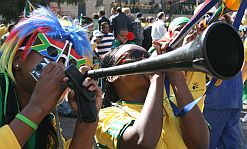
The Vuvuzela: Bafana’s 12th man
by Bongani Nkosi Some find it quite annoying, and others even want it banned from stadiums, but South Africans love it dearly: it spurs the crowds on and is the very best local way to show support for Bafana Bafana. It’s called the vuvuzela, a long plastic trumpet that can make quite a racket – […]

by Bongani Nkosi
Some find it quite annoying, and others even want it banned from stadiums, but South Africans love it dearly: it spurs the crowds on and is the very best local way to show support for Bafana Bafana.

It’s called the vuvuzela, a long plastic trumpet that can make quite a racket – just ask the Japanese football squad about it. They complained it distracted them so much during the Confederations Cup here in 2009, that it should be banned.
But Fifa refuses to outlaw this controversial noise-maker, saying it’s a vital part of South African football culture and has cleared it for entry into World Cup stadiums.
Hate it or love it, this ear-splitting apparatus will be out in force during the upcoming matches – and will certainly be louder than ever when the local boys take to the pitch.
The vuvuzela is no newcomer to the local football scene, though. For years it’s been used to spark the atmosphere, with fanatics blowing it with vigour for 90-plus minutes of the game and during post-match celebrations.

Fifa has said it will only turn away vuvuzelas if they’re used to attack other fans in the stadiums, but that’s never been the case before. And considering that the trumpets are associated with joy and celebration, and are cherished by their owners, it’s not likely to happen in the next month either. The instrument’s place in the 2010 Fifa World Cup is guaranteed.
“I’d to be the first man to be arrested if they say the vuvuzela is banned,” said Freddie “Saddam” Maake, a devoted Bafana and Kaizer Chiefs fan, who is largely recognised as the inventor.
“If it was not allowed into the stadium, it would mean we’d not go inside. We would blow our vuvuzelas outside the stadium,” he said.
“I said to the Japanese fans: in your country you have karate … the Brazilians have samba. Here we have the vuvuzela.”
Heed the call
The trumpet has become such a phenomenon in the country, that it’s impossible to imagine an ardent local fan going to a stadium without it.
David Mabu, a devoted Bafana supporter, believes it’s the bellowing sound of the vuvuzela that pushes the national team to perform at its best. “Our boys understand it very well, they respond to it.
“Blowing vuvuzelas is our way of encouraging our boys,” said Mabu, who’s also an ardent Kaizer Chiefs man.
Bafana coach Carlos Parreira has also come out in defence of the popular trumpet, calling it South Africa’s 12th player on the field.
Mabu says the vuvuzela craze has grown to such an extent, that there’s now a family of related objects on the market: the kuduzela, sockzela, babazela, mamazela, vuthela and nyinyizela.
All of these are modelled on the traditional plastic horn, but come in different sizes and designs. And they all make different sounds. “That’s how unique we South African fans are,” said Mabu.
But what’s the vuvuzela’s origin?

There are now more than 40 companies that produce vuvuzelas, according to Maake. And one of them has even trademarked the name.
This has led to a raging dispute about its origins, but what is clear is that the vuvuzela came was introduced by vibrant local fanatics.
Maake, who’s been a diehard fan for decades, claims he is the chief creator. It was back in the 1980s, he said, when he started using a similar-looking instrument, made from aluminium, to stir excitement at matches.
Back then he was a Moroka Swallows fan – fresh from the Limpopo province – and he called his noise-maker a lemporo, a sePedi name.
Maake has long been a trendsetter at local matches and it’s easy to spot him on the grandstand, always wearing eye-catching attire. His vuvuzela is attached to a cut-out of an animated Bafana fan figure sticking out his tongue, and is elaborately decorated. Alfred “The Magistrate” Baloyi, the man credited for inventing the makarapa, was the designer of the piece.
It was in 1989 that Maake first presented the idea of a plastic vuvuzela to businessman Peter Rice. The trumpet’s name changed to boogie blast, as it gained popularity.
I was the only one making noise with a horn-like object then, Maake said. “When I was the only person blowing the thing people thought I was crazy.”
In 1999 the versatile Maake, who’s also a musician, released an album called Vuvuzela Cellular, which led to the trumpet’s current name.
Maake’s concern today is that South Africans do not recognise him as the person who invented the popular item. “I know that I’m the founder of the vuvuzela,” he said.

Mabu, who’s been attending Bafana and Kaizer Chiefs matches religiously for the past five years, gives credit to Maake as the main man behind the vuvuzela. “The first person I saw having a vuvuzela was him, to be honest,” he said.
Other companies are now able to mass-produce it because Maake never patented the design, but the musician says he is pleased that his alleged invention has become a national asset – not least in his own home, where he has about 300 different models.
“When I’m in a stadium seeing 80 000 people blowing vuvuzelas that makes me happy,” he said. Today everyone is blowing a vuvuzela, even three-year-olds. It’s free entertainment for South Africans.”